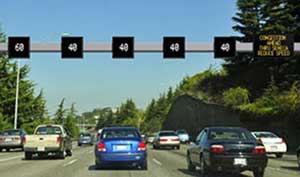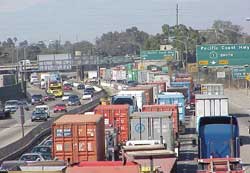Research is a major focus of UCTC’s activities. In the Working Plan established for FY 2012, the following areas were identified as priorities.
Our consortium focuses on three themes identified by USDOT in its strategic plan—environmental sustainability, economic competitiveness, and livability—and, importantly, the connections between them. Advancing each of these objectives is important in and of itself; however, our UTC recognizes that the three are closely inter-twined and oftentimes co-dependent. Our UTC will thus give particular attention to the synergies that can be created and cross purposes that are served when working in a coordinated fashion on all three fronts.
Environmental sustainability is vital for creating clean, healthy, and functional cities and regions of the future. The transport of people and goods consumes nearly three-quarters of the nation’s petroleum, emits around a third of greenhouse gases, and is responsible for around half of urban air pollution. Fossil fuel-based travel also negatively impacts air quality, water quality, and habitat quality, with serious implications for economic well-being, human health, natural ecologies, and the long-term environmental sustainability of the planet. Finding ways to shrink the sector’s ecological footprint are national, state, and local priorities.
 Economic competitiveness has always been a core focus of transportation planning and engineering since efficient transportation systems and operations are vital toward sustained economic growth and prosperity. The nation’s economy relies crucially on its systems of highways, ports, and mass transportation to swiftly and safely move raw materials, labor, manufactured products, component parts, and ideas to produce and exchange goods and services. Bottlenecks on highways leading to and from ports, unreliable mass transit systems, and deteriorating traffic conditions can strangle economic growth and, if left unchecked, place America’s cities and regions at a global economic disadvantage. In 2009, the congestion “invoice” for the extra time and fuel spent moving people and goods in America’s 439 urban areas reached $115 billion. Policy-makers well understand this. The Economist Intelligence Unit Global Survey, released in September 2010, reported that 61 percent of mayors worldwide believed that “improving public transport and roads” is the most important way “to make their cities more competitive for businesses.” As home to the busiest port in the nation and four of America’s 22 most congested urbanized areas, California has a vested economic stake in planning, designing, operating, managing, and pricing multi-modal transportation facilities and services in the most efficient, resourceful way possible.
Economic competitiveness has always been a core focus of transportation planning and engineering since efficient transportation systems and operations are vital toward sustained economic growth and prosperity. The nation’s economy relies crucially on its systems of highways, ports, and mass transportation to swiftly and safely move raw materials, labor, manufactured products, component parts, and ideas to produce and exchange goods and services. Bottlenecks on highways leading to and from ports, unreliable mass transit systems, and deteriorating traffic conditions can strangle economic growth and, if left unchecked, place America’s cities and regions at a global economic disadvantage. In 2009, the congestion “invoice” for the extra time and fuel spent moving people and goods in America’s 439 urban areas reached $115 billion. Policy-makers well understand this. The Economist Intelligence Unit Global Survey, released in September 2010, reported that 61 percent of mayors worldwide believed that “improving public transport and roads” is the most important way “to make their cities more competitive for businesses.” As home to the busiest port in the nation and four of America’s 22 most congested urbanized areas, California has a vested economic stake in planning, designing, operating, managing, and pricing multi-modal transportation facilities and services in the most efficient, resourceful way possible.
 Livability continues to gain importance as a national, state, and local goal because it is intimately related to social well-being, peoples’ attachment to community and place, and healthy living. Livable communities feature well-designed streetscapes, attractive civic spaces, the inter-mixing of land uses, “complete streets” that promote walking and cycling, and Safe Routes to School. Such environments are increasingly in high demand. We know this not only from public opinion polls but also real-estate markets. High-quality urban and suburban districts and well-designed places often command sizeable rent and land-value premiums. Importantly, the livability movement elevates accessibility, i.e., the ability of people to reach the places they wish to go, as an overarching goal in transportation planning and investment. Expediting traffic flows is certainly critical to creating accessible cities and regions, but so are urban designs that bring trip origins and destinations closer and information-technological advances that allow social and economic interactions without necessarily physical movements.
Livability continues to gain importance as a national, state, and local goal because it is intimately related to social well-being, peoples’ attachment to community and place, and healthy living. Livable communities feature well-designed streetscapes, attractive civic spaces, the inter-mixing of land uses, “complete streets” that promote walking and cycling, and Safe Routes to School. Such environments are increasingly in high demand. We know this not only from public opinion polls but also real-estate markets. High-quality urban and suburban districts and well-designed places often command sizeable rent and land-value premiums. Importantly, the livability movement elevates accessibility, i.e., the ability of people to reach the places they wish to go, as an overarching goal in transportation planning and investment. Expediting traffic flows is certainly critical to creating accessible cities and regions, but so are urban designs that bring trip origins and destinations closer and information-technological advances that allow social and economic interactions without necessarily physical movements.
The linkages between environmental sustainability and economic competitiveness, we believe, are especially important. Besides attracting high-skilled firms and creative classes of workers, global cities with clean air, generous amounts of public spaces, attractive urban designs, and functional transportation and infrastructure systems are excellent incubators for growing the green economy. Advances in the production and distribution of clean-fuel vehicles that operate on renewable energy sources can stimulate private investment and create new employment and vocational opportunities.
